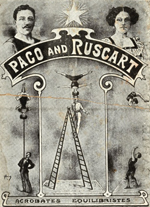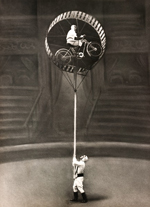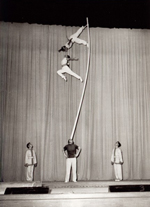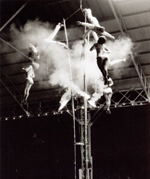by Pascal Jacob
Perch pole acts have existed in China since the reign of the Song dynasty. The use of an apparatus aimed at symbolically uniting two bodies while also weakening their respective stability reinforces the allegorical dimension of the performance. The perch pole is like a link between two existing entities, but it is also a beautiful piece of apparatus, used for extremely spectacular technical sequences. A traditional exercise performed by the Rajasthani tumblers sees an acrobat balance on his stomach at the top of bamboo pole several metres high. A similar feat sees a child climb to the top of a bamboo pole topped with a small platform, held at arm's length by a carrier. There is a striking contrast between the apparent lightness of the child, the length of the bamboo pole and the impression of extreme vulnerability given by the feat in its entirety. Around 1857, Hayatake Torakichi, a Japanese artist, performed a number identified as "Kyokuzashi," two long bamboo poles balanced on the shoulders, on which an acrobat, juggler or drag artist stood. In an echo of these feats, a painted scroll from the Edo period (1615-1868) preserved at the New York Metropolitan Museum also shows acrobats balancing on a long perch pole anchored in the ground.
The Chinese specialty banner act, initially performed at traditional ceremonies and street parades, is a substitute for pole perch work, but consists mainly in manipulating 9 metre-long bamboo poles decorated with long pieces of brightly coloured silk, which carriers would balance on their foreheads or shoulders, or would throw various distances, creating an astonishing display of strength and dexterity.
A rare technique
In the west, perch pole work, which is rather rare in comparison to other disciplines, knows no limits. In France in the 1970s, the Kalikoas and the Siberas regularly performed similar numbers combining performance, a hint of dramatization and a touch of humour. In 1999, when Barnum's Kaleidoscope was created, the Bulgarian Petrov duo made the perch pole technique more complex by climbing a diagonal cable and performing a développé on a tightrope. The Kailafov, a Russian family company, performed a number in which the perch poles were assembled in improvised fashion, creating ever more complex structures, used for spectacular balancing acts at a great height. For a long time, the Guangdong province military troop had a group perch pole act in their repertoire. Acrobats balancing on wooden spheres carried the poles on their shoulders. Acrobats at the top of each pole performed sequences of figures and jumps between poles.
The discipline is not really taught in western schools, but in the coming decades will probably see a stylistic and technical evolution, driven by the still largely unexplored.artistic possibilities of the apparatus.







